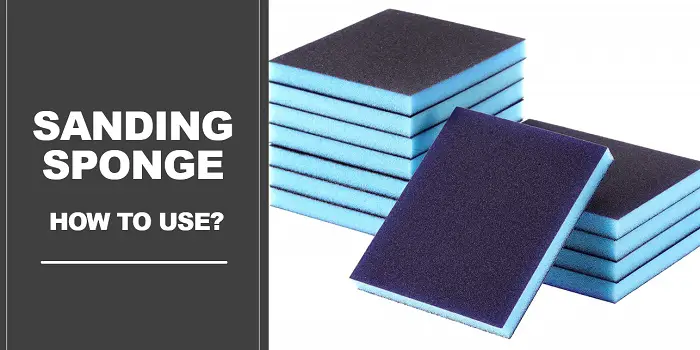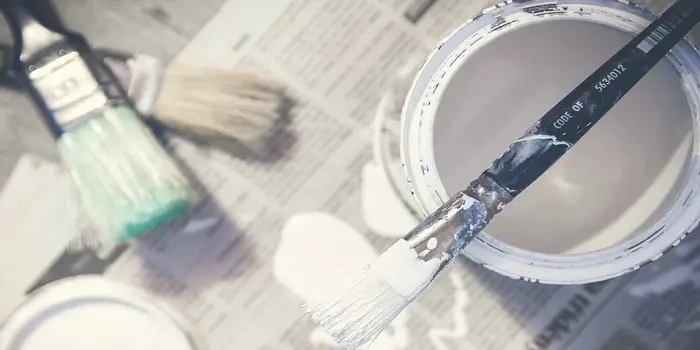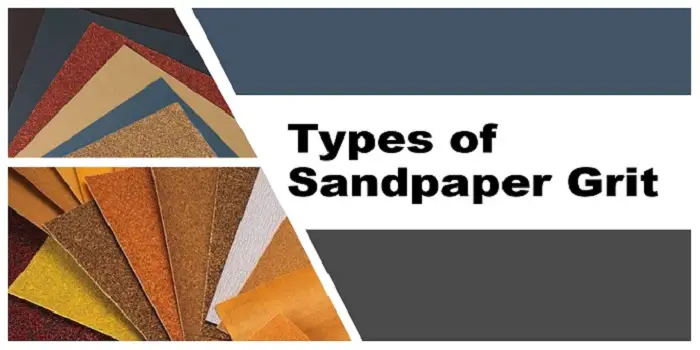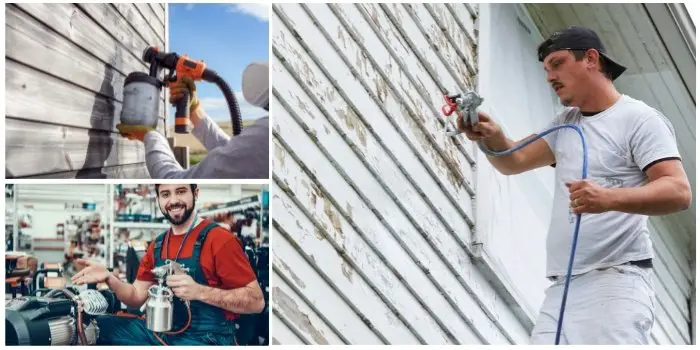
When it comes time to complete a house paint project, there are many ways to go about it. One popular option is to use a paint sprayer.
Electric paint sprayers are great for small to medium-sized projects. They work by using an electric motor to pump the paint through the hose and into the nozzle.
Most of these are handheld and designed for those who need to be able to move around while they are painting. They are also convenient for those who do not have a lot of space to set up a larger paint sprayer.
What's Here in the Article:
Types of Paint Sprayers
Whether you want a sprayer to paint furniture, walls, or entire rooms, paint sprayers come in all shapes and sizes. So it can be tough to decide which one is right for your needs.
Let’s take a look at different types of paint sprayers and discuss the pros and cons of each one for your next paint project.
1. Airless paint sprayers
The airless paint sprayer operates without compressed air, utilizing an electric pump to propel paint through the sprayer’s tip, resulting in a fan or arc of paint. This method ensures paint adherence to surfaces, leaving behind a smooth finish.
Unlike other models, this electric spray gun requires minimal preparation and is instantly ready for use. While it efficiently covers large areas in a short time, making it ideal for finishing walls or entire properties, mastering its speed requires practice. Working too slowly with the airless paint sprayer can result in overspray, where multiple coats are applied to the same spot, leading to uneven wall coverage and increased paint usage.
However, beyond its coverage benefits, the electric spray gun may not be the optimal choice for all scenarios. It is less effective for outdoor use, a limitation common to all types of paint sprayers. Moreover, its tendency for overspray makes it unsuitable for precision work. Therefore, individuals seeking to spray furniture may not achieve the desired results with an airless sprayer.
2. HVLP paint sprayers
The HVLP, or High-Volume, Low-Pressure paint sprayer, is renowned for its precision capabilities. Operating at lower pressure levels, it releases a reduced amount of paint from the tip, mixed with air molecules used for pressurization. This design lends itself to easier control, minimizes mess, and enhances suitability for precision tasks. Its gradual and precise paint delivery ensures even coverage, making it an optimal choice for meticulous tasks.
Ideal for painting trims, crown molding, or intricate carpentry details (like on furniture and doors), the HVLP sprayer’s low pressure restricts it to thinner paints. Despite using thinner liquids, it may still encounter clogging issues, necessitating regular cleaning. The HVLP’s limitations become apparent in volume work, as it would significantly prolong the time required to paint an entire room. Additionally, its low-pressure operation mandates a short hose, resulting in frequent carrying or movement, potentially causing user fatigue and inconvenience.
3. LVLP paint sprayers
LVLP, or Low-Volume, Low-Pressure, spray painters operate efficiently at around 10PSI, making them ideal for DIY enthusiasts who can utilize basic and cost-effective air compressors. Their compact size distinguishes them from other devices, allowing users to conveniently carry the entire unit, including the paint tank or reservoir, while in use. The emphasis on emitting a low-volume load ensures portability.
The LVLP sprayer stands as the preferred choice among homeowners due to its affordability, ease of use, and capability to handle reasonably sized projects, despite becoming cumbersome during prolonged use.
It’s relatively lightweight compared to other models. However, for tasks such as painting entire interior walls or the exterior of a property, a more potent option is advisable because it lacks significant power and speed for more extensive projects.
LVLP sprayers are also not suitable for thick paints due to their low volume. They require frequent refills due to their limited capacity.
4. Compressed air paint sprayers
Compressed air sprayers, such as LVLP guns, are considered the most user-friendly among paint sprayers. They operate by utilizing a compressor to generate compressed air, which is then propelled through the paint reservoir. This process pushes the paint through the hose and out of the nozzle or tip of the device.
While they are straightforward to operate and generally less costly than electric models, they are gradually being phased out due to their inability to provide the same level of consistency and uniformity as electric units, as well as their lack of power. Additionally, their performance heavily relies on the quality and power of the accompanying compressor system. Nonetheless, they remain popular for artisanal applications such as painting cabinets and furniture.
Electric sprayers are gradually overtaking compressed air spray guns. Compressed air units are less powerful, more susceptible to clogging, and slower when covering large areas. They are commonly used by cabinetmakers, DIY enthusiasts crafting their own furniture, and artists. They also serve as a convenient option for individuals who already possess a compressor system and seek a straightforward yet effective solution for painting extensive surfaces.
5. Gravity feed paint sprayer
The gravity feed spray gun, named for its paint reservoir positioned above the sprayer, is engineered to deliver a precise finish. Similar to HVLP systems, it can apply multiple layers to the surface being worked on. Utilizing a siphoning mechanism at the gun’s top, the gravity feed sprayer operates at lower pressure compared to alternative options. This results in exceptional accuracy, minimal overspray, and reduced cleanup.
Commonly employed in automotive painting, it excels in this field. While not suitable for large-scale projects, it’s an excellent choice for adding finesse to your work. Initially utilized in automotive applications, the gravity sprayer is highly valued for its capability to apply clear coats effectively. Nowadays, it finds utility across a broad spectrum of projects.
A Few Less Common Options
Besides the above, there are a few other sprayers that I would like to mention. Although they are less popular for house paint jobs, you should at least know that they exist. These are typically used in industrial settings and are not so useful for DIYers or house painters.
a) Piston sprayers are a type of airless paint sprayer that uses a piston instead of a pump to atomize the paint, making them more lightweight and portable. These are great for small to medium-sized projects.
b) Diaphragm sprayers are similar to piston paint sprayers in that they are more lightweight and portable. However, they use a diaphragm instead of a piston to atomize the paint.
c) Electrostatic sprayers use electricity to charge the paint particles. This makes them attracted to the surface of your project, which means less paint is wasted. These sprayers are great for large projects, as they can quickly cover a lot of surface area.
d) Turbine paint sprayers are similar to compressed ones in that they use a turbine to power the motor. However, they are designed for larger commercial projects and can quickly cover a lot of surface area.
e) Thermal paint sprayers use heat to atomize the paint and are great for large projects, as they can quickly cover a lot of surface area. They are similar to compressed air paint sprayers in that they require a power source (in this case, an electrical outlet). However, they can be more difficult to use than other types of paint sprayers and require more cleanup.
f) Battery-powered paint sprayers use a battery to power the motor, which means they are completely portable. These are a great option for those who do not have access to an electrical outlet and need to move around a lot while they are painting.
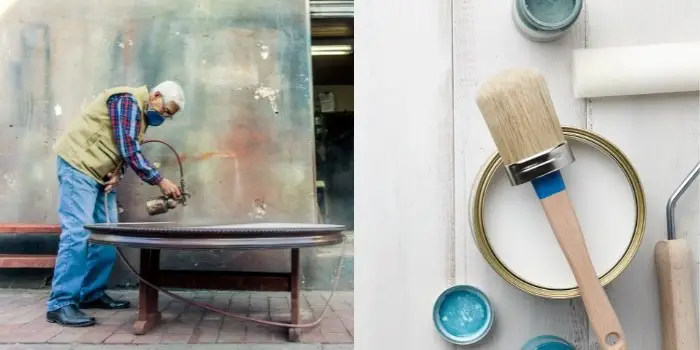
Paint Sprayers vs. Brushes: What’s Better?
When it comes to painting, deciding between paint sprayers and brushes/rollers hinges on the project’s nature and personal preference.
Paint sprayers when chosen wisely offer speed and efficiency, swiftly covering large surfaces with a smooth, even coat of paint. They also shine in tasks like painting cabinets, doors, or furniture, where achieving a flawless finish is paramount. However, they necessitate meticulous masking to avoid overspray, and mastering their technique requires practice. Also, the cleanup process is a bit complicated and time-consuming.
Conversely, brushes and rollers offer greater control over the application process, making them perfect for smaller projects or areas needing precise detailing. Though slower than sprayers, they are easier to use and entail less cleanup.
Ultimately, the optimal choice depends on factors such as project size, surface type, desired finish, and individual skill level. From what I have discovered from my personal experience, employing a blend of both tools produces superior results, capitalizing on their respective strengths for enhanced efficiency and quality.
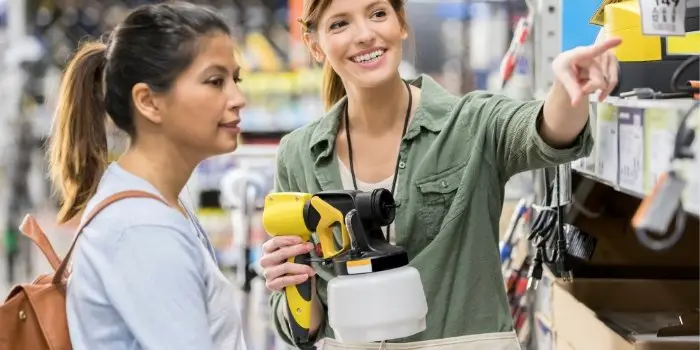
Choosing the Best Paint Sprayer for Home Use- Buyer’s Guide
As paint sprayers gain popularity for both interior and exterior projects, navigating the variety of brands, styles, and types available can be daunting. To aid in your decision-making process, let’s delve into the key features you should consider when purchasing a paint sprayer…
a) Capacity:
The size of the paint sprayer’s tank is a critical factor to consider initially. Larger tanks are preferable for extensive projects as they require fewer refills, enhancing efficiency. Conversely, for smaller household tasks, a compact tank may suffice, minimizing unnecessary bulk.
b) Size and portability:
When selecting a paint sprayer, two crucial features to prioritize are the size and portability of the model. For smaller household projects, a handheld model proves sufficient, boasting lightweight construction and ease of maneuverability. These models often feature a detachable hose for convenient storage when not in use.
Conversely, for larger-scale endeavors or extensive painting tasks, opting for a wheeled model is advisable. While bulkier in size, these models offer enhanced mobility with built-in wheels for effortless transport. Additionally, they typically feature a larger tank, enabling longer painting sessions without the need for frequent refills.
c) Power Source:
Paint sprayers come in both electric and gas-powered variants. Electric models are generally more affordable and simpler to operate, although they may lack the power of their gas-powered counterparts. Gas-powered models, while pricier and requiring more maintenance, are better equipped for larger projects due to their increased power and efficiency.
d) Paint Type:
Another crucial consideration when selecting a sprayer is the type of paint you intend to use. While water-based paints are the most prevalent, oil-based paints also remain an option. It’s essential to note that certain paint sprayers are compatible only with one type of paint, while others accommodate both.
e) Nozzle Type & Spray Pattern:
Paint sprayers feature various types of nozzles tailored to the specific paint being used. Some sprayers offer multiple nozzles, accommodating different project needs, while others are equipped with a single nozzle type.
Additionally, paint sprayers offer different spray patterns to achieve desired results. For instance, models with a horizontal spray pattern are optimal for covering large surfaces, while those with a vertical spray pattern excel in painting trim and smaller areas.
f) Filters & Adjustable Pressure:
Many paint sprayers are equipped with filters designed to eliminate impurities from the paint before spraying. Some sprayers feature disposable filters that require replacement after each use, while others boast reusable filters that can be cleaned and reused. Regular inspection and cleaning or replacement of these filters are essential as they can become clogged over time.
Additionally, adjustable pressure settings are a common feature in many paint sprayers, enabling precise control over the paint release. This functionality proves invaluable for avoiding overspray and achieving the desired thickness of paint application.
g) Price & Warranty:
Sprayers are available across a wide price range, spanning from approximately $50 to $500. Establishing a budget before shopping is crucial. It’s worth noting that the most expensive option may not necessarily be the best fit for your requirements; rather, it depends on the specific features you prioritize.
As with any tool or appliance purchase, checking the warranty is also essential. Some paint sprayers offer a limited warranty covering defects in workmanship, while others provide a full warranty encompassing defects and damages.
Related FAQs
Is Airless or HVLP Better?
Airless paint sprayers are more powerful and can handle thicker paints, but they’re also more expensive and require more maintenance. Conversely, HVLP (High Volume Low Pressure) paint sprayers are less expensive and easier to operate, but they’re not as powerful and can’t handle thicker paints.
Single Unit Sprayers vs. Two-Part Sprayers?
Single-unit paint sprayers are easier to operate, but they’re not as powerful and can only be used with water-based paints. Two-part paint sprayers on the other hand are more expensive and require more maintenance, but they’re more powerful and can be used with both water-based and oil-based paints.
Will Paint Spraying Uses More Paint Than Brushing?
Paint spraying typically uses more paint than brushing, but it’s also more efficient and will give you a better finish. Brushing is still an option if you’re working on a small project or if you want to save money on paint.
You will also need to be cautious about over spraying, which can be a problem with sprayers if you do not use them correctly and at the right angle. This can even leave your painted work tacky for long without drying.
The Conclusion
To sum up, selecting the right paint sprayer is crucial for achieving quality and efficiency in your home projects. However, choosing the ideal sprayer hinges on several factors including your level of expertise, desired coverage, level of detail required, and budget.
Whether you choose an airless, HVLP, handheld, pneumatic, or compressed air sprayer, each type offers unique features suited to different surfaces, projects, and skill levels. Understanding the characteristics and applications of each type enables you to make an informed decision, enhancing the final results of your painting endeavors while simplifying the process.
Share the post "5 Different Types of Paint Sprayers (for Home Painting)"

Douglas Becker (aka Painter Doug) has over twenty years of experience as a painter in Adkins, Texas. At present, he resides in Florida with his family.
From painting multi-storeyed houses, condos, and apartments to large commercial buildings and small offices, he had served various customers in areas not only in Adkins but also in Southwest Florida, Sarasota, Naples, and many more. To know more about him check here.


